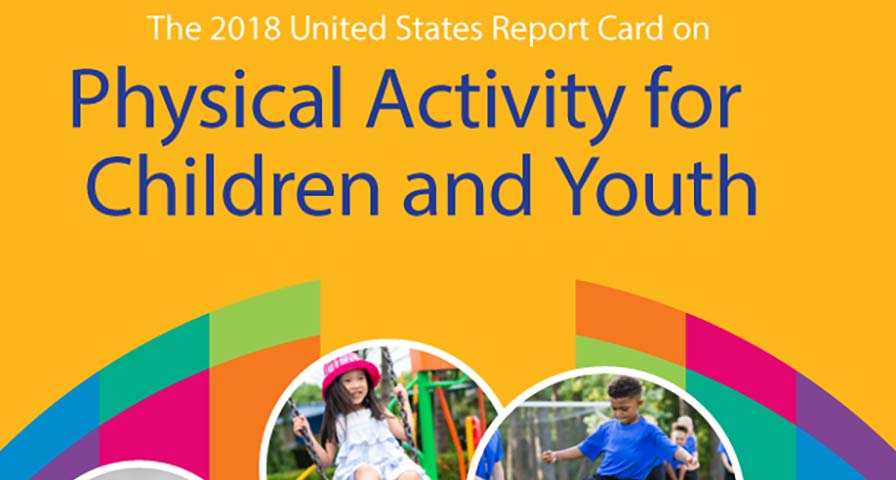Originally published Oct. 2, 2018 in the American College of Sports Medicine.
The National Physical Activity Plan Alliance (NPAPA) today released its 2018 United States Report Card on Physical Activity for Children and Youth. This is the third comprehensive assessment of physical activity in U.S. children and youth, updating the first report card released in 2014 and the second released in 2016. While the overall physical activity grade for children and youth remained low at D-, the 2018 report card revealed positive signs, especially related to opportunities and infrastructure that supports physical activity in children and youth. The Report Card includes grades for nine specific indicators, individual state data, and recommendations for how grades can be improved.
The report card is an advocacy tool that provides accountability and a call-to-action for decision-makers regarding how parents, teachers, health professionals, community leaders, and policymakers can implement new initiatives, programs and policies to improve the physical activity levels and health of children and youth.
 “This report card continues to provide reliable data that helps assess both progress and barriers to physical activity for our children,” said Peter T. Katzmarzyk, Ph.D., chair of the alliance’s Report Card Research Advisory Committee. “Clearly, there is significant work to do in removing existing barriers, but we are encouraged by the progress we’re seeing on multiple fronts.”
“This report card continues to provide reliable data that helps assess both progress and barriers to physical activity for our children,” said Peter T. Katzmarzyk, Ph.D., chair of the alliance’s Report Card Research Advisory Committee. “Clearly, there is significant work to do in removing existing barriers, but we are encouraged by the progress we’re seeing on multiple fronts.”
The U.S. Report Card grades nine separate indicators of a child’s access to and participation in physical activity. Promising highlights from the 2018 report card include the following:
- Almost all school districts have policies requiring schools to meet the physical education needs of students with disabilities.
- Approximately 75% of 6 to 17-year-old children live in a neighborhood with sidewalks or walking paths.
- Approximately 77% of 6 to 17-year-old children live in a neighborhood with a park or playground area.
- More than 50% of children and high school students have played on a sports team in the past year.
- Approximately 65% of school districts have policies requiring elementary schools to provide regularly scheduled recess, while another 31% of districts recommend elementary schools do so.
- More than half of children aged 6 to 15 years have adequate muscular endurance.
- More than 70% of school districts have a policy that requires undergraduate or graduate training in PE or a related field for newly hired staff who teach PE in elementary, middle school and high school.
“While these positive results are encouraging and provide a glimpse into what’s possible, there is no denying that the overall grades for the indicators remain critically low,” said Russell Pate, board chair for the National Physical Activity Plan Alliance. “This report card should generate a renewed sense of urgency to take the action needed for the sake of our children and their future.”
The nine indicators and 2018 grades are as follows:
- Overall Physical Activity: D-
- Sedentary Behaviors: D
- Active Transportation: D-
- Organized Sport Participation: C
- Active Play: INC
- Physical Fitness: C-
- Family and Peers: INC
- School: D-
- Community and Built Environment: C
Another important outcome of the 2018 Report Card was the identification of critical gaps that exist in certain demographics, including gender, race/ethnicity, age, ability and household income. The research is clear that physical activity levels are not equal, and the findings can provide a roadmap for addressing these gaps and overcoming barriers to increased physical activity.
- Gender: Approximately 35% of high-school boys but only 18% of high-school girls report participating in at least 60 minutes of daily physical activity.
- Age: Children aged 6-11 years participate in more daily physical activity (88 minutes) compared to adolescents aged 12-15 years (33 minutes) and 16-19 years (26 minutes).
- Ability: Children with mobility limitations may engage in less physical activity than those without limitations. 58% of boys aged 5-11 years with long-term mobility limitations met physical activity recommendations compared to 75% of boys without limitations.
- Place of residence: Children aged 6-11 years living in high-crime neighborhoods participate in less physical activity than those living in low-crime neighborhoods. Safe neighborhood park access was associated with more physical activity and less inactivity among adolescents 12-17 years old.
Seeking IHT Spirit System information?




